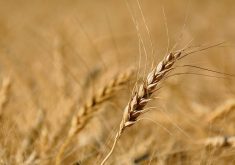Winter wheat variety evaluation will become increasingly important as 2013 approaches. Many Manitoba farmers will be affected by Canadian Grain Commission plans to move CDC Kestrel, CDC Clair, CDC Harrier, CDC Raptor and CDC Falcon from the Canada Western Red Winter (CWRW) class to the Canada Western General Purpose (CWGP) class as of August 1, 2013.
CDC Falcon has always been popular, largely due to its short stature and strong straw strength. In 2011, Falcon represented 72.5 per cent of the total winter wheat acres grown in Manitoba. The grain commission has stated it will extend the transition period for CDC Falcon if insufficient alternative varieties are available to Manitoba farmers.
Read Also

Senft to step down as CEO of Seeds Canada
Barry Senft, the founding CEO of the five-year-old Seeds Canada organization is stepping down as of January 2026.
However, now is the time to start evaluating the new CWRW varieties coming soon. To assist, MCVET (Manitoba Crop Variety Evaluation Team) is publishing the most recent variety descriptions and performance data collected in 2011. Although yield is generally the first information looked at and the main focus of this article, farmers also need to compare varieties for maturity, height, standability and resistance to disease in selecting a variety that is best suited to their farm.
Reading the tables
Yield is based on the genetic potential and environmental conditions in which the crop is grown. Farmers should look at long-term, multi-site data and select those varieties that perform well not only in their area but across locations and years. This will increase the likelihood that given next year’s environment (which cannot be controlled) the variety selected will perform well.
Long-term data can be found in the 2011 Winter Wheat Variety Descriptions table. The “Yield per cent Check” column provides an indication of how the listed varieties performed compared to the check CDC Falcon. Remember that only direct comparisons can be made between CDC Falcon and the variety chosen to compare it to.
The “Site Years Tested” column shows the number of sites where the variety has been tested in the same trial as CDC Falcon. The more site years, the more dependable the data. For example, CDC Buteo and McClintock have 63 and 69 site years of data compared to CDC Falcon so farmers can be fairly confident of those yield comparisons. The varieties Flourish and Moats have six site years of data compared to CDC Falcon, which represents the six locations in the 2010/11 growing season. More caution must be exercised when evaluating the performance of these two varieties as the data only represents one year of data.
The grey “Check Characteristics” box displays the long-term yield in bushels per acre for CDC Falcon, the number of site years CDC Falcon has been tested by MCVET and the height in inches of CDC Falcon. The height data, along with days to maturity, lodging, relative winter hardiness, and disease resistance data is obtained from the Co-operative Registration Trials.
Comparing by location
Multi-site data for 2011 can be found in the 2011 Winter Wheat Yield Comparisons table. Individual site data is presented for the six locations available for publication by our deadline. Within this table comparisons are not restricted to CDC Falcon. For example, comparisons can be made between Flourish and Moats at a chosen location. To do so, you will need the information provided in the grey shaded area located at the bottom of the table.
For example, you want to compare the performance of Flourish and Moats at Boissevain. The first step will be to look at the “Sign Diff” value in the Boissevain site column. Sign Diff stands for significant difference and a “yes” or “no” will indicate if a real difference exists between varieties at an individual site. At Boissevain, there is a significant difference between the varieties tested. You then need to look at the “LSD per cent” value. LSD stands for Least Significant Difference and it shows the percentage that individual varieties must differ by to be considered significantly different. Since Flourish and Moats do not differ by more than 12 per cent, statistically those varieties yielded the same at the Boissevain site.
For each site, the yield of CDC Falcon in bushels per acre (bu/ac) is also presented at the bottom of the table. Using this information, you can convert the yield percentages to bushels per acre values. For example, at Boissevain the yield of CDC Falcon is 61 bu/ac. Using this information you can convert the yields of Flourish and Moats to 63 and 59 bu/ac respectively.
Interestingly enough, if you look at Arborg there is no significant difference (Sign Diff) between the 13 varieties. This is not entirely unexpected as the current registration system selects for varieties with consistent yields across a wide range of regions/growing conditions.
While data from single sites is often more interesting, individual site data, and even data accumulated over several sites in a single year must always be viewed with caution — varieties that excel under one set of environmental conditions may not perform as well under the next year’s conditions.
More winter wheat varieties coming
Plans are currently underway to test 14 winter wheat varieties in the 2011-2012 MCVET winter wheat trials. This includes W454 from AAFC Lethbridge which will be eligible for the CWRW class. W454 has been noted to have improved fusarium head blight resistance compared to currently available varieties. This is of particular interest to Manitoba farmers, especially if there is good yield potential under Manitoba growing conditions and the agronomic and disease package is suited to the production practices on their farm.
MCVET will continue to provide the latest unbiased information on new winter wheat varieties. Yield data for the winter wheat sites that did not meet publication deadlines for this article, along with 2011 protein data, will be published in Seed Manitoba 2012 this December.















